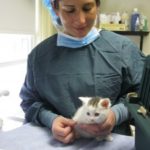What causes cats to scratch?

Scratching behavior is a normal part of being a feline. Cats use scratching on objects to remove the dying sheaths of the nail, marking territory and stretching their muscles. Undesirable scratching behavior in cats, destroying objects in the home or scratching people in the home, is responsible for up to 42% of feline behavior complaints. Onychectomy is a surgical procedure aimed at removing the claws of a cat to prevent this potentially destructive behavior.
What is involved in a declaw?
Unfortunately unlike human nails, cat’s nails grow from the germinal cells of the third phalanx or finger bone on their paws. In order to make sure that the nail is removed and will be unable to grow back, the third finger bone is surgically removed. Veterinarians will remove the finger bone with sterilized guillotine nail trimmers, a surgical blade or laser. The paws are then bandaged to prevent bleeding as the surgical sites are not routinely sutured. Imagine having your finger bones surgically removed!
Why would anyone do this to their cat you ask? Well, as mentioned above, undesirable scratching is responsible for behavior complaints and in some cases relinquishing of the cat. But there are other ways of stopping a cat from scratching furniture, wood work and you!
The new philosophy on declaws
When I first started practicing veterinary medicine, declawing was a routine procedure at the animal hospital where I worked. It sort of was a given that the indoor cat would be declawed at the time of their spay or neuter. (for more information on spay and neuter….) Since that time through client awareness and education, most clients are unwilling to declaw their cat and put them through this elective painful surgical procedure in order to protect their couch. The Cat Clinic of Plymouth no longer provides this service unless required by a medical condition of the cat or it’s human. Most other first world countries have also banned the declawing of cats for convenience.
“The AVMA or American Veterinary Medical Association official position on declawing cats is this…
The current AVMA policy on Declawing of Domestic Cats recommends that the procedure
only be performed after exhausting other methods of controlling scratching behavior or if it has been
determined that the cat’s claws present a human health risk.”
From Literature Review on the Welfare Implications of Declawing of Domestic Cats, February 2016
How to prevent scratching?
There are other more humane ways of preventing undesirable scratching behavior in cats and avoid declaw.
- Keeping the nails trimmed
- Providing acceptable alternatives for your cat to scratch i.e. cat scratching posts (see “How do I train my cat not to scratch my furniture?”)
- Training to not scratch inappropriate objects including people (see “Why does my cat scratch me?”)
- Nail Caps that glue onto the nail to prevent damage when scratching
- Facial pheromone diffusers or sprays
- Environmental Enrichment (see “Enriching Your Environment for Cat Happiness”)
By Cassandra Kelley DVM, Cat Clinic of Plymouth










